Auxiliary Spacecraft Systems
Created by Commodore Wilkan Targaryen on Sat Dec 21st, 2024 @ 1:19pm
Shuttlebays
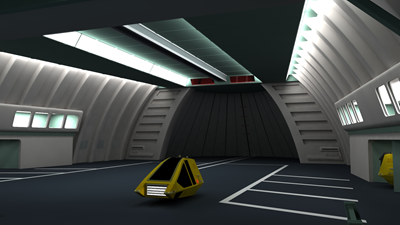 Among the largest locations aboard a Federation Starship, the Shuttlebay aboard the Starship Enterprise is a massive, open area that is assigned the task of launching the vessel's auxiliary craft. The Century Class incorporates three Shuttlebays within its superstructure. Shuttlebays 1 and 2 are located in the Primary Hull and are connected via an expansive hangar deck that provides storage space for the Enterprise's support vehicles. Shuttlebay 3, also known as the Main Shuttlebay, is located in the Engineering Hull and is the location furthest aft aboard the vessel.
Among the largest locations aboard a Federation Starship, the Shuttlebay aboard the Starship Enterprise is a massive, open area that is assigned the task of launching the vessel's auxiliary craft. The Century Class incorporates three Shuttlebays within its superstructure. Shuttlebays 1 and 2 are located in the Primary Hull and are connected via an expansive hangar deck that provides storage space for the Enterprise's support vehicles. Shuttlebay 3, also known as the Main Shuttlebay, is located in the Engineering Hull and is the location furthest aft aboard the vessel. Managed by the Flight Deck Operations Officer, each Shuttlebay aboard the Enterprise is constantly monitored and managed from its nearby Control Room. Landing procedures are closely managed with the Enterprise's computer assuming control of the craft during its descent into the bay. Runabouts, Shuttlecraft, and other auxiliary vehicles enter the Enterprise's Shuttlebay through its attached airlock door. Colossal in size, the exterior airlock doors are made of triple-layered duranium with an interior of lightweight neofoam sheeting in an expanded tritanium framework to support the massive structure. While the Shuttlebay doors are open, containment fields engage to maintain atmospheric integrity within the Shuttlebay.
Hangar Bay
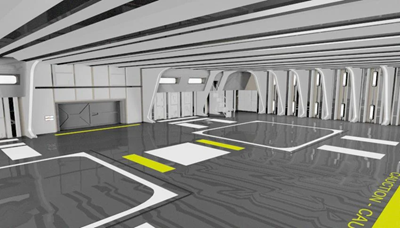 While Shuttlebays are used for the launching of Shuttlecraft and other support vessels, the Hangar Bay is actually used for the storage of these vehicles. Comprised of multiple decks, the Hangar Bay maintains all necessary equipment and supplies to ensure the safe operation of the Enterprise's support craft and visiting vessels. Assigned a small army of Engineering Technicians, the Hangar Bay incorporates multiple small compartments to conduct maintenance upon assigned craft and includes dedicated fuel reserves for usage on the shuttles. Nearby Cargo Bays store necessary parts and allow for the quick offloading of cargo from shuttles into appropriate storage bays.
While Shuttlebays are used for the launching of Shuttlecraft and other support vessels, the Hangar Bay is actually used for the storage of these vehicles. Comprised of multiple decks, the Hangar Bay maintains all necessary equipment and supplies to ensure the safe operation of the Enterprise's support craft and visiting vessels. Assigned a small army of Engineering Technicians, the Hangar Bay incorporates multiple small compartments to conduct maintenance upon assigned craft and includes dedicated fuel reserves for usage on the shuttles. Nearby Cargo Bays store necessary parts and allow for the quick offloading of cargo from shuttles into appropriate storage bays.
Landing Pad
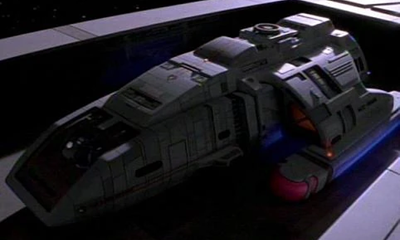 Located on the upper surface of the Enterprise's Saucer Section, Landing Pads are specialized platforms that can be used to lower a spacecraft into the Hangar Bay. Utilized for larger vehicles, Landing Pads are ideally suited for docking procedures involving Runabout sized vessels, regardless of the affiliated government.
Located on the upper surface of the Enterprise's Saucer Section, Landing Pads are specialized platforms that can be used to lower a spacecraft into the Hangar Bay. Utilized for larger vehicles, Landing Pads are ideally suited for docking procedures involving Runabout sized vessels, regardless of the affiliated government.Upon approach to the Century Class vessel, the spacecraft requesting permission to dock would first request clearance to dock from the Main Bridge. The Operations Manager would assign one of three Landing Pads for the vessel to utilize for docking. In routine operations the vessel would turn control over to the Enterprise's Main Computer for docking maneuvers; however, the option to proceed manually is also available. The shuttle would descend onto the Landing Platform and disengage its primary engines prior to the pad descending into the Hangar Bay. Once inside the Hangar, exterior doors would seal the craft inside the bay and allow the visitors to disembark and access the Enterprise.
Support Craft
Captain's Yacht
Also known as the Captain's Gig, the Captain's Yacht is a secondary craft that is used at the discretion of the Commanding Officer. While capable of a variety of missions, the Captain's Yacht is normally used during diplomatic missions or to escort diplomats without the need for a transporter.
Waverider II Class
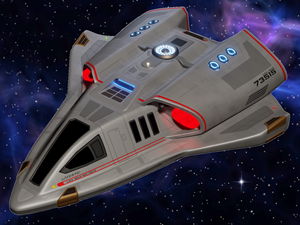 | |
| Affiliation: | Federation Starfleet |
| Length: | 28.8 meters |
| Width: | 23.8 meters |
| Height: | 6.2 meters |
| Crew: | 6 personnel 50 evacuation |
| Speed: | Warp 8.4 |
| Armament: | Pulse Phaser Cannons |
| Defenses: | Deflector Shields Reactive Armor |
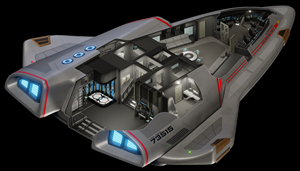 | |
Overview
Merging the original design of the Waverider Class support vessel and the Flyer Class Runabout designed by the crew of the U.S.S. Voyager, the Waverider II Class scout was designed to overcome several deficiencies in the design of its direct predecessor. Intended to reinforce the scientific and tactical capabilities of their Nova Class motherships, the Waverider II has been equipped with a Warp Propulsion System based upon technologies utilized by the Delta Flyer and an enhanced weapons suite allowing it to serve as an effective patrol and scout vessel; nonetheless, it is still a more scientifically oriented than combat capable craft. Through further design innovations the Waverider II has also been equipped with enhanced maneuverability within a planetary atmosphere, allowing it to effectively operate in a planetary atmosphere for long periods of time.
Capabilities
The Waverider II is an older vehicle, but that makes it no less capable than its next generation counterparts. The Waverider II has been equipped for short and medium duration interstellar missions as well as interplanetary trips thanks to its Warp Drive. Where the Waverider II thrives is in atmospheric travel. While several of the Federation's neighboring governments had designs that excelled in atmospheric operations, the Waverider II was the first Starfleet design that was highly maneuverable within a planetary atmosphere since the Class F Shuttle of the 23rd Century. The Waverider II accomplishes this feat through a specialized ramscoop built into the Impulse Drive, allowing the Waverider II to operate in a planetary atmosphere near indefinitely, including gas giants.With a range comparable to a runabout, the Waverider II has a standard crew of six when in operation and can be deployed for up to six months without needing to be resupplied. The Waverider II excels in its creature comforts when compared to other comparably sized craft, except for maybe the Captain's Yacht of the Galaxy or Sovereign Class. Outfitted with a forward cockpit, the Waverider II contains a small cargo bay (with emergency medical capabilities), two staterooms, and a shared lounge that can be used for relaxation or formal meetings.
Waverider II Class Vessels Assigned to the U.S.S. Enterprise NX-1701-H | |||
| Galileo Galilei | 1701-H/01 | Docking Bay 1 | Named in honor of the Human astronomer, physicist and engineer. |
Runabout
Designed to serve in a variety of mission profiles, the Runabout was designed to permit long-term away missions away from a mothership. Smaller than a starship but larger than a shuttlecraft, the Runabout first became popular in the mid-24th Century through the discovery of the Bajoran Wormhole when Danube Class Runabouts were frequently assigned to survey missions in the Gamma Quadrant. Runabouts can be quickly reconfigured due to their modular compartments, and are often used as a tug or for other rescue operations when not on exploratory assignment.
Polaris Class
 | |
| Affiliation: | Federation Starfleet |
| Length: | 24.2 meters |
| Width: | 16.7 meters |
| Height: | 5.9 meters |
| Crew: | 4 personnel 50 evacuation |
| Speed: | Warp 7.2 |
| Armament: | Phaser Arrays Photon Microtorpedoes |
| Defenses: | Deflector Shields |
 | |
Overview
Named after stars located within Federation territory, the Polaris Class Runabout is a recently developed support craft that is significantly advanced when compared to its predecessors. The Polaris Class is intended to supplement long-range, deep space exploratory vessels and current deployment practices involve members of the class being dropped off by their mothership while underway to their destination to conduct more thorough investigations before returning home. This policy is achieved through advancements in the Warp Propulsion Systems of the Polaris, granting the vessel a greater operational range than previous generations of runabouts, which grants the craft the capability of maintaining independent operations for up to six months before refueling. In addition to its exploratory role, Polaris Class vessels are planned to routinely engage in patrol, scientific investigation, starbase support, and transport operations.
Capabilities
Designed to be a jack-of-all trades vessel, Polaris Class vessels are able to complete a variety of objectives. Each Polaris Class ship has been designed to maintain the modular capabilities of previous generations of runabouts, with the central compartment of the Polaris being a mission configurable component that can be swapped out with a prefabricated module. Previous generations of runabout required a brief layover at a starbase for the modules to be exchanged; however, thanks to advancements in technology, the Polaris Class can have its module replaced by a standard engineering team aboard a Federation starship in less than three hours. While there are over a dozen available modules currently produced by Starfleet (with models designed to support logistics, medical, scientific investigation, and tactical operations), the number of modules currently deployed to exploratory vessels are limited due to storage needs. In addition to the modular components within the superstructure of the Polaris, a mission configurable pod could also be attached to the dorsal hull to enhance the capabilities of the vehicle.Polaris Class ships employ heavy automation systems, which allows the craft to be successfully operated by a single person, but Starfleet guidelines require a minimum of four people aboard per deployment. For a craft its size the Polaris Class is well armed with Phaser and Photon Microtorpedo Launchers as standard, which can be further enhanced with a configurable tactical module and/or a specialized tactical mission pod. With a maximum top speed of Warp 7.2, which can be maintained for up to 18 hours before slowing, the Polaris is capable of representing the Federation and its interests well.
Polaris Class Vessels Assigned to the U.S.S. Enterprise NX-1701-H | |||
| Sol | 1701-H/02 | 03 | Named in honor of the Terran System star. |
Rio Grande Class
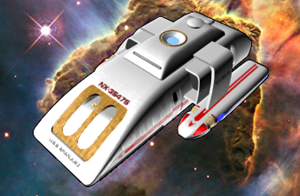 | |
| Affiliation: | Federation Starfleet |
| Length: | 19.3 meters |
| Width: | 11.6 meters |
| Height: | 5.9 meters |
| Crew: | 2 personnel 20 evacuation |
| Speed: | Warp 6.9 |
| Armament: | Phaser Arrays Photon Microtorpedoes |
| Defenses: | Deflector Shields |
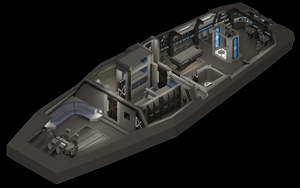 | |
Overview
The Rio Grande Class Runabout was constructed to serve as the next generation scoutship for Starfleet, taking on low-risk assignments where a starship's usage may be impractical. Developed at the Bajoran Okana Shipyards, the Rio Grande Class was named in honor of the Danube Class U.S.S. Rio Grande, which was the runabout piloted by Commander Benjamin Sisko and Lieutenant Jadzia Dax on the mission that first discovered the Bajoran Wormhole in 2369. While smaller than the typical runabout, the Rio Grande Class has quickly become the leading support vessel produced by Starfleet and maintains the naming traditions of the Danube Class, with vessels being named after bodies of water.
Capabilities
Rio Grande Class Runabouts inherit the legacy of the Danube Class before them, serving the need for a small craft that could operate on short-duration, long-range missions with limited support from a larger mothership. Each ship of the Rio Grande Class is able to maintain a sustained top speed of Warp 6.9 and can go for up to three months without having to refuel at its home base. While not as large as their predecessor, the Rio Grande Class allows the replacement of its central module with mission-specific equipment and supplies by a starship's crew without the need of putting into a starbase for maintenance. Its size has made the Rio Grande popular within Starfleet as it can be effectively housed within the shuttlebays of smaller starships without significantly impacting the operations of the spacecraft, with the Rio Grande having replaced the older Valkyrie Class for supporting survey teams in planetary and cultural surveys.While the standard crew complement of a Rio Grande Class Runabout is only two persons, each vessel of the design has been equipped to be self sufficient and are more than capable of defending themselves from harm. The capabilities of the Rio Grande are enhanced by the installation of a configurable mission pod along the dorsal superstructure of the craft, with typical configurations enhancing the sensor telescopes or allowing additional weapons to be fitted. In its default configuration the Rio Grande has a full complement of Phasers and Photon Microtorpedoes available for combat needs. Normally launched with a flight crew of two personnel, there are few missions that a Rio Grande Class Runabout does not excel in.
Rio Grande Class Vessels Assigned to the U.S.S. Enterprise NX-1701-H | |||
| Frost River | 1701-H/03 | 01 | Named in honor of the Frost river on Andoria. |
| Hurutam River | 1701-H/04 | 02 | Named in honor of the Hurutam river on Tellar Prime. |
| Monongahela River | 1701-H/05 | 01 | Named in honor of the Monongahela river on Earth. |
| Na'ree River | 1701-H/06 | 02 | Named in honor of the Na'ree river on Vulcan. |
Dominion Strike Fighter
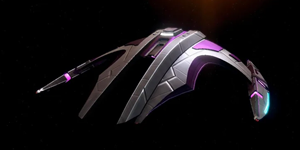 | |
| Affiliation: | The Dominion Federation Starfleet |
| Length: | 22.5 meters |
| Width: | 18.5 meters |
| Height: | 5.1 meters |
| Crew: | 13 personnel |
| Speed: | Warp 9.2 |
| Armament: | Photon Torpedoes Polaron Pulse Cannon Turrets |
| Defenses: | Deflector Shields |
Originally considered as little more than manned drone ship, the Dominion Strike Fighter is a lightweight and easily replaceable spacecraft employed by the Dominion. Effective as a short-range attack vessel, the Dominion Strike Fighter is limited in range but makes up for it with an impressive tactical suite.
Overview
When initially conceived the Dominion Strike Fighter was based upon the hull design utilized by the Dominion Scout Ship brought into service during the Dominion War. Roughly the size of a Federation Runabout, the Dominion Strike Fighter's outward design is based upon the much larger Dominion Battlecruiser and was originally intended to perform scouting missions and light patrol assignments along borders with 'friendly' neighbors. As the Dominion began encountering more hostile species following the Dominion War, the scout design was modified to serve as a Strike Fighter.
Capabilities
When initially conceived the Dominion viewed the Dominion Scout Ship as little more than a drone; however, thanks to the influence of Odo the Dominion began efforts to increase the survivability of the Dominion Scout, which has bled through to the Strike Fighter. Similar to the Dominion Dispatch Vessel, the Strike Fighter incorporates Warp Field Coil Enhancers that allow it to maintain high Warp for longer periods than other comparable vessels. The Strike Fighter has been further enhanced with the ability to directly modify its Warp Field Geometry, allowing it to lessen the size of the Warp Field to make the Strike Fighter more difficult to detect at long-range. The Impulse Engines are also enhanced, allowing the Strike Fighter to accelerate at faster rates than its Dispatch and Scout counterparts.As a Strike Fighter the vessel is well prepared for tactical operations and rivals some frigate type vessels in offensive capability. The primary weapon of the Strike Fighter are twin Polaron Pulse Cannon Turrets that are located on the sides of the forward prow of the Fighter that are comparable in devasting power to the standard Jem'Hadar Attack Ship. Two Photon Torpedo Launchers are also located in the forward prow, allowing the vessel to target enemy vessels with the projectile weapon. Shields aboard the Strike Fighter are slightly weaker than a Jem'Hadar Attack Ship, but are able to withstand heavy punishment.
Dominion Strike Fighters Assigned to the U.S.S. Enterprise NX-1701-H | ||
| DSF-3751 | Landing Pad B | Temporarily Assigned to the U.S.S. Enterprise. |
Shuttlecraft
Shuttlecraft are small auxiliary vessels that are utilized by Starfleet forces to complete short-range, and short-term assignments. While not as large as a Runabout, Shuttlecraft are warp capable vessels that can travel between star systems. Normally, Shuttles are assigned to cargo and passenger transport missions, or they may take away teams to an assignment. Commonplace throughout the Federation, the shuttles of yesterday often move from their military role to civilian ownership as new designs come into play.
Type 18 Shuttlecraft
 | |
| Affiliation: | Federation Starfleet |
| Length: | 9.7 meters |
| Width: | 3.8 meters |
| Height: | 2.9 meters |
| Crew: | 2 personnel 6 evacuation |
| Speed: | Warp 5.3 |
| Armament: | Dual Mount Phaser Emitter Photon Microtorpedoes |
| Defenses: | Deflector Shields Reactive Armor |
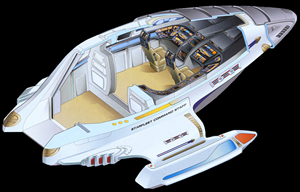 | |
Overview
Intended as the natural successor for the Type 9 Shuttlecraft, the Type 18 Shuttlecraft was designed to fill the need for a fast, short-range interplanetary vessel that could quickly transport passengers between planets, stations, and other vessels. Primarily used for away missions, the Type 18 Shuttle lacks many of the creature comforts that personnel are accustomed to on larger starships and runabout type vessels, but makes up for these deficits with its speed. Despite its size limitations, the Type 18 has earned a reputation for its reliability, survivability, and versatility which has led to its continued operation over 30 years since it was first commissioned.
Capabilities
Fast and maneuverable, the Type 18 Shuttlecraft could maintain Warp 5.3 for up to 24 hours and has been fitted with advanced impulse thrusters for sublight travel inside a solar system. To aid in its missions, the Type 18 has been equipped with high-efficiency Warp Coils allowing for greater control over the Warp Field. When necessary, personnel could adjust the Warp Field into a slender profile, making the shuttle harder to detect at range by normal sensor scans. Composed of tritanium alloy, the Type 18 features a traditional design layout and includes a cockpit with a small cargo area located directly behind in the aft compartment. Bulkhead mounted benches were available for passengers to sit in the cargo area during long flights and small cabinets were located in the area that held consumables, emergency supplies, and environmental suits. The pilot of a Type 18 Shuttle could be fitted with a synaptic transceiver assembly, a specialized implant that would connect the pilot directly to the shuttle's systems for better control over the shuttle's operations.While the engines of the Type 18 are advanced, they fail in comparison to the shuttle's weapons and defensive capabilities. While the primary defensive system for the Type 18 remains Deflector Shields, the shuttle is equipped with Reactive Armor. Reactive Armor, next generation ablative armor, is a standard defense aboard the Type 18 and allows the shuttle to withstand prolonged attack that would have destroyed prior ships. Dual Beam Phaser Emitters have been installed on the forward edge of the Type 18, as well as a single Microtorpedo Launcher that is normally loaded with Photon shells.
Type 18 Shuttlecraft Assigned to the U.S.S. Enterprise NX-1701-H | |||
| Robert April | 1701-H/07 | 02 | Named in honor of U.S.S. Enterprise Captain Robert April. |
| Willard Decker | 1701-H/08 | 01 | Named in honor of U.S.S. Enterprise Captain Willard Decker. |
| James T. Kirk | 1701-H/09 | 02 | Named in honor of U.S.S. Enterprise-A Captain James T. Kirk. |
| Christopher Pike | 1701-H/10 | 01 | Named in honor of U.S.S. Enterprise Captain Christopher Pike. |
| Spock | 1701-H/11 | 02 | Named in honor of U.S.S. Enterprise Captain Spock. |
Type 19 Shuttlecraft
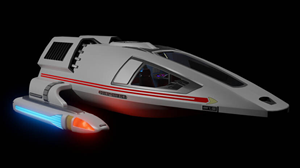 | |
| Affiliation: | Federation Starfleet |
| Length: | 10.0 meters |
| Width: | 4.3 meters |
| Height: | 2.9 meters |
| Crew: | 2 personnel 10 evacuation |
| Speed: | Warp 5.7 |
| Armament: | Dual Mount Phaser Emitter |
| Defenses: | Deflector Shields |
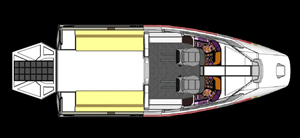 | |
Intended to be a jack-of-all-trades shuttlecraft, the Type 19 Shuttlecraft is a short-range vehicle intended for away missions and interplanetary transport. Designed to complement the Type 18 Shuttle, the Type 19 is a capable craft, but is not as popular within Starfleet as its older cousin.
Overview
Inspired by the Starfleet Class C shuttle in use during the Federation/Klingon War of the 2250s, the Type 19 Shuttlecraft was intended by Starfleet to become their new flagship shuttlecraft design when it was devised at the Oakland Shipyards. Taking many design cues from its Type 18 counterpart, the intention behind the Type 19 was to develop a robust shuttlecraft with modular components that would allow the vehicle to meet a diverse mission profile; however, as with the Danube Class in the 24th Century, many compromises were needed for the Type 19 to come to fruition and many of the objectives of the design were never achieved.
Capabilities
The greatest advantage obtained by the Type 19 Shuttlecraft was the successful development of a large, customizable interior that could be modified to meet the priorities of the mission profile that the shuttle was being assigned. Like the Rockwell Class-C Shuttle that it was based upon, the Type 19 was outfitted with a cockpit at the front of the vehicle that maintained seating for two pilots and a large cabin area with accommodations for up to eight passengers. While the Type 19 is equipped with advanced propulsion systems, the vessel's range is slightly less than its Type 18 counterpart. The shuttle incorporated its own dedicated transporters and was able to successfully transport four persons concurrently either to or from the shuttle. Appropriate supplies were available in the aft compartment for passengers in the event of an emergency.When initially proposed the Type 19 was intended to feature a robust reconnaissance package for close observation of the borders of neighboring governments; however, the power profile of the Type 19 prevented this plan from coming to fruition. Of the initial plans the only component that remained in the final design was the inclusion of a forward mounted Phaser emplacement below the Navigational Deflector for defensive purposes; however, the slim sensor profile adds to the shuttle's defensive capabilities.
Type 19 Shuttlecraft Assigned to the U.S.S. Enterprise NX-1701-H | |||
| Jonathan Archer | 1701-H/12 | 01 | Named in honor of Enterprise NX-01 Captain Jonathan Archer. |
| Rachael Garrett | 1701-H/13 | 02 | Named in honor of U.S.S. Enterprise-C Captain Rachael Garrett. |
| Jean-Luc Picard | 1701-H/14 | 01 | Named in honor of U.S.S. Enterprise-D Captain Jean-Luc Picard. |
| Demora Sulu | 1701-H/15 | 02 | Named in honor of U.S.S. Enterprise-B Captain Demora Sulu. |
| Worf | 1701-H/16 | 01 | Named in honor of U.S.S. Enterprise-E Captain Worf. |
Type 20 Shuttlecraft
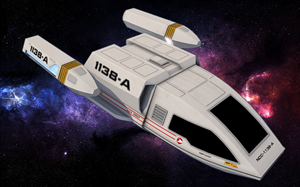 | |
| Affiliation: | Federation Starfleet |
| Length: | 12.5 meters |
| Width: | 4.8 meters |
| Height: | 2.7 meters |
| Crew: | 2 personnel 12 evacuation |
| Speed: | Warp 5.1 |
| Armament: | Single Mount Phaser Emitter |
| Defenses: | Deflector Shields |
 | |
Overview
While runabout type vessels have excelled in their spheres of responsibility since being first deployed in the 24th Century, Starfleet Command had long seen the need for a smaller craft that was capable of specialist assignments like those of the runabout. Starfleet Command ordered the Engineers at Baikonur Cosmodrome, designers of the Type 7 Shuttlecraft of the 24th Century, to begin work on the new Type 20 Shuttlecraft.
Capabilities
Designated as a long-range shuttlecraft, the Type 20 was designed to be the backbone of Starfleet's future exploratory services. Based upon the frame of the Type 6 Shuttlecraft, the Type 20 Shuttle features a small cockpit area seating two with a configurable compartment directly adjacent. Isolated by a pressure door, the specialist area could be configured for a variety of roles to meet the mission profile needed. Commonly, these vessels are launched with a combination of the cargo and passenger role; nonetheless, the Type 20 may be configured to support cargo only or to ferry up to 12 passengers to their destination. Starfleet Medical has recently petitioned for testing of a fourth configuration to allow the Type 20 Shuttle to serve as a long-range Ambulance Shuttle capable of supporting two patients concurrently, while Starfleet Sciences has approved a fifth compartment that serves as a specialized laboratory.Capable of maintaining a maximum speed of Warp 5.1 for up to 36 hours, the Type 20 is somewhat slower than its contemporaries but makes up for this with its endurance. Due to the presence of specialist equipment, energy consumption is a constant problem aboard the Type 20 Shuttlecraft as the shuttle’s energy was often used to support the specialist mission profile, maintain life-support, and for propulsion systems. Should the vessel come under attack the vessel was lightly armed with a single forward Phaser emitter and standard shields, making the Type 20 operating on its own and away from Federation territory a less than appealing prospect.
Type 20 Shuttlecraft Assigned to the U.S.S. Enterprise NX-1701-H | |||
| John Harriman | 1701-H/17 | 03 | Named in honor of U.S.S. Enterprise-B Captain John Harriman. |
| Va'Kel Shon | 1701-H/18 | 03 | Named in honor of U.S.S. Enterprise-F Captain Va'Kel Shon. |
Shuttlepod
Shuttlepods are small craft that are typically assigned to short-term assignments within close distance to their mothership. Incapable of interstellar voyages, Shuttlepods typically lack faster-than-light propulsion systems and weapons and are used for close range transport when the Transporters are unavailable.
Type 25 Shuttlepod
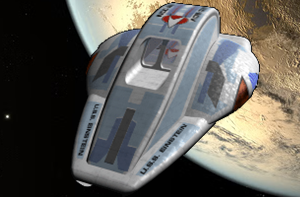 | |
| Affiliation: | Federation Starfleet |
| Length: | 4.4 meters |
| Width: | 3.3 meters |
| Height: | 1.7 meters |
| Crew: | 1 personnel 2 evacuation |
| Speed: | Full Impulse |
| Armament: | Phaser Turret |
| Defenses: | Deflector Shields |
 | |
Overview
Inspired by its predecessor, the Type 18 Shuttlepod, the Type 25 Shuttlepod was designed to serve as the next generation orbit to surface shuttlepod used by Starfleet personnel. A compact vehicle, the Type 25 Shuttlepod was primarily intended to move personnel and small amounts of cargo between nearby orbital habitats, planets, spacecraft, and space stations when transporter systems would be impractical. Constructed without faster-than-light propulsion systems and with a limited armament, the Type 25 as designed would highly dependent upon its mothership for support and wouldn't stray far while on routine assignment.
Capabilities
Entered through an airlock built into the aft bulkhead, the Type 25 Shuttlepod is a compact vessel comprised of only a single interior compartment. Designed to be operated by a single pilot in its default configuration, seating for a second crewmember could be added depending upon the assignment given. Due to the limited space available, passenger comfort is a major concern aboard the Class 25 Shuttlepod, which has led Starfleet Command to issue protocols that missions using this type of craft may not exceed 12 hours, even in emergency situations. The passenger seating could be removed for missions in which the Type 25 would need to transport cargo, with equipment and/or supplies held behind the operator's station during transit.While under development Starfleet Command initially planned for a compact Warp Propulsion System to be installed to allow the Type 25 to travel at low Warp velocities; however, due to size constraints, the Corps of Engineers were unable to fulfill this mission mandate. Instead, the Type 25 Shuttlepod is powered by a small Impulse Propulsion System that feeds two Impulse Nacelles located on the exterior hull of the vehicle. As a tradeoff, the Corps of Engineers designed the Type 25 to offer superior handling within a planetary atmosphere thanks to its atmospheric ramscoop, similar to the one employed by the old Class F Shuttle of the 23rd Century. The Type 25 is also lightly armed with a defensive Phaser turret that can be used in combat operations should the craft come under attack, as well as a powerful subspace transmitter that can be used to call for help from its nearby mothership.
Type 25 Shuttlepods Assigned to the U.S.S. Enterprise NX-1701-H | |||
| William George | 1701-H/19 | 03 | Named in honor of U.S.S. Enterprise-B Captain William George. |
| Edward Jellico | 1701-H/20 | 01 | Named in honor of U.S.S. Enterprise-D Temporary Captain Edward Jellico. |
| Thomas Johnson Jr. | 1701-H/21 | 03 | Named in honor of U.S.S. Enterprise-B Captain Thomas Johnson Jr. |
| Demián Rendón | 1701-H/22 | 03 | Named in honor of U.S.S. Enterprise-B Temporary Captain Demián Rendón. |
| William T. Riker | 1701-H/23 | 02 | Named in honor of U.S.S. Enterprise-D Temporary Captain William T. Riker. |
| Elizabeth Shelby | 1701-H/24 | 03 | Named in honor of U.S.S. Enterprise-F Temporary Captain Elizabeth Shelby. |
Extravehicular Activity (EVA)
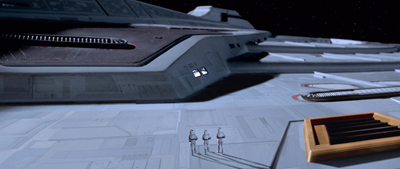 Extravehicular activity (EVA) is an operation where one or more crewmembers must exit the Enterprise into outer space or another hostile environment to complete an assigned task. The most common EVA activity completed by Starfleet personnel are Spacewalks in which the crew exit the vessel to either access the hull or space itself and these types of EVAs may be tethered (the crewmember is connected to the spacecraft) or untethered. Almost every EVA requires the usage of a protective suit to keep the crewmember safe during their assignment.
Extravehicular activity (EVA) is an operation where one or more crewmembers must exit the Enterprise into outer space or another hostile environment to complete an assigned task. The most common EVA activity completed by Starfleet personnel are Spacewalks in which the crew exit the vessel to either access the hull or space itself and these types of EVAs may be tethered (the crewmember is connected to the spacecraft) or untethered. Almost every EVA requires the usage of a protective suit to keep the crewmember safe during their assignment.
Cargo Management Unit (Workbee)
 | |
| Affiliation: | Federation Starfleet |
| Length: | 2.7 meters |
| Width: | 1.2 meters |
| Height: | 2.7 meters |
| Crew: | 1 personnel |
| Speed: | 5,000 kph |
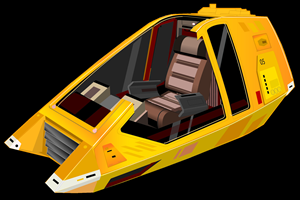 | |
Overview
With the rapid expansion of Starfleet in the mid-23rd Century following the Federation/Klingon War, Starfleet found itself in need of a small utility craft capable of independent operations to support the assembly, inspection, and repair of Starfleet Space Stations and Starships. The Corps of Engineers developed several conceptual designs for the new Cargo Management Unit, but ultimately selected the "Workbee" design, so named because of the cautionary yellow hull markings on the vehicles hull that resembled the striping of the Earth honey bees.Capabilities
When originally launched the Workbee featured very few systems to support the immense power needs that the technical support equipment needed to execute the craft's tasks. While the majority of the equipment installed is standard - including spotlight and panoramic transparent aluminum windows - the primary power draw aboard the vehicle are the Engineering tools installed on the vessel's modular equipment mounts which include connections for the vehicle to tow cargo pods, manipulator arms, welding and cutting torches, sensors to inspect maintenance needs, and even a tool box. The. Often, these tools overwhelm the electrochemical fuel cells that power the vessel, draining the ship's batteries and limiting its operational mission time to a little under 12 hours. To compensate for the energy demands Starfleet Command authorized the initial waves of Workbees to be devoid of life-support (necessitating that users wear environmental suits), but even this failed to make reasonable accommodations to the needs of the vessel.Despite its early challenges, the Workbee has proven itself as a capable Engineering tool and has withstood the test of time to remain active nearly 175 years after its initial order was completed. Barely larger than the humanoid piloting it, the Workbee has benefited greatly from the growth of miniaturization in the late 24th Century. Modern Workbees are outfitted with a compact fusion reactor that generates power far in excess of the original electrochemical fuel cells. These improvements in energy management have allowed the installation of a small life-support system, but Technicians are still required to wear EVA suits due to a potential need to exit the craft to complete a task.
Extravehicular Activity (EVA) Suit
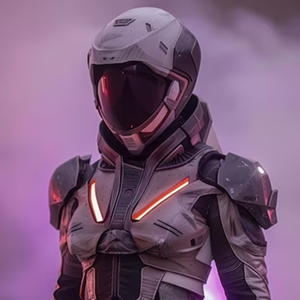 Due to advancements in safety technology made throughout the years, a single Extravehicular Activity (EVA) suit is currently assigned to Starfleet vessels. Form-fitting and lightweight, the EVA Suit is issued to the Enterprise's crew when mission protocols dictate their need, such as exiting the vessel to the vacuum of space, exploring a planet with limited atmosphere, or exposure to radiation to name a few.
Due to advancements in safety technology made throughout the years, a single Extravehicular Activity (EVA) suit is currently assigned to Starfleet vessels. Form-fitting and lightweight, the EVA Suit is issued to the Enterprise's crew when mission protocols dictate their need, such as exiting the vessel to the vacuum of space, exploring a planet with limited atmosphere, or exposure to radiation to name a few.Primarily stored within the Enterprise's Airlocks, EVA Suits are also kept in emergency lockers for quick deployment to personnel should there be risks of exposure to hazardous materials. Capable of full mobility, the EVA Suit features a multi-layered construction to maintain atmospheric integrity and is nondescript, except for an internal glow displaying the user's divisional color. Standard mission duration for a Starfleet issued EVA Suit is up to 12 hours (or two duty shifts), but the suit maintains emergency resources and other supplies for 24 hours of continuous usage before system failure. An internal computer processor closely monitors the suit's integrity and efficiency, allowing the user control over the internal systems including communications, life-support, and the suit's magnetic boots. As needed the EVA Suit can be fitted with an external thruster pack as well, enhancing maneuverability for the user, as well as a tether system to keep the user close to their spacecraft.
Categories: Operations | Command | Medical